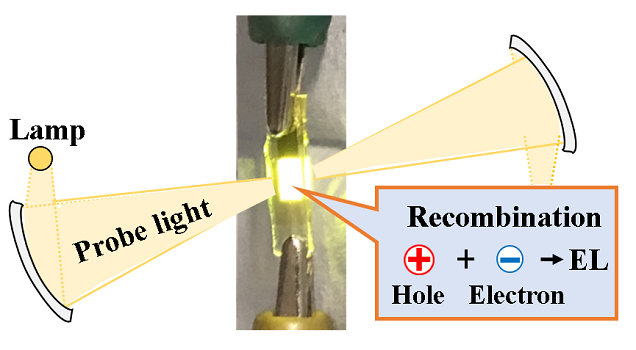Research News
Mar 14, 2023
Observations open door to improved luminous efficiency of organic LEDs
Electronic state changes during electroluminescence measured
Electroluminescence measurement experimental setup
Lamp light passes through the light-emitting electrochemical cell (LEC), driven by square wave bias, to observe signal absorption using spectrophotometry. Electroluminescence (EL) generates light when electrons recombine with electron holes, shedding excess energy in the form of photons.

Electroluminescence is the production of light with an electrical current, without relying on heat or chemical reactions. This makes electroluminescent lights reliable and highly efficient: they are used as backlights in digital watches and in the displays of Apollo space shuttle guidance computers. Like OLEDs, light-emitting electrochemical cells (LECs)—which emit light through electroluminescence—have undergone many technological advancements. Close examination of the processes that lead to luminescence is essential for improving luminescence efficiency, however, until now there has been no experimental method for examining these processes directly.
A research team led by Professor Katsuichi Kanemoto from the Graduate School of Science and the Nambu Yoichiro Institute of Theoretical and Experimental Physics at Osaka Metropolitan University, has successfully observed changes in the electronic state of LECs over time during field emission, by measuring their optical absorption via lamp light irradiation for the first time.
Their findings were published in Nature Communications where it was selected for the Editors' Highlights.
The researchers published their review article on single-molecule reaction dynamics in solution pioneered by nanofluidic devices, in the January 2023 issue of TrAC Trends in Analytical Chemistry. As pioneers in this new field, the review provides a bird's eye view, including the forefront of research and development, future challenges, and where new these discoveries may lead.
Electroluminescence occurs when electrons recombine with electron holes—areas that could hold an electron, but which lack them. When an electron enters the hole it releases energy, in the form of a photon. Analysis of the results revealed that the luminescence mechanism of LECs follows a two-step process.
(1) After the voltage is applied, holes in the LEC are generated immediately, and the layer that accommodates these holes grows close to the interface with the electron-side electrode before recombining with a few electrons to generate the electroluminescence.
(2) The amount of electroluminescence then becomes steady while the layer that accommodates electrons gradually grows at the same rate as the hole layer recedes.
“The spectroscopic observation method used in this study is applicable not only to the LECs but to all light-emitting devices, including OLEDs,” explained Professor Kanemoto. “Using this technique we expect to reveal the details of the electroluminescence process and furthermore, it will lead to the early detection of processes that interfere with device operation. In the future, we will strive to shorten the measurement time of our system to create a rapid device diagnosis system.”
Funding
This work was supported in part by JSPS KAKENHI Grant (number 17H03135) and by the Osaka City University (OCU) Strategic Research Grant 2017 for basic researches.
Paper Information
Journal: Nature Communications
Title: Visualizing electroluminescence process in light-emitting electrochemical cells
DOI: 10.1038/s41467-023-36472-6
Author: Kosuke Yasuji, Tomo Sakanoue, Fumihiro Yonekawa, Katsuichi Kanemoto
Publish: March 1, 2023
https://doi.org/10.1038/s41467-023-36472-6
Contact
Graduate School of Science
Katsuichi KANEMOTO
E-mail: kkane [at] omu.ac.jp
*Please change [at] to @.
SDGs
